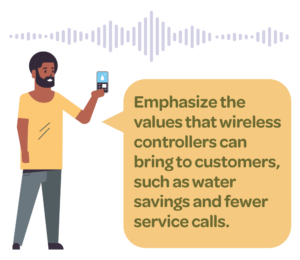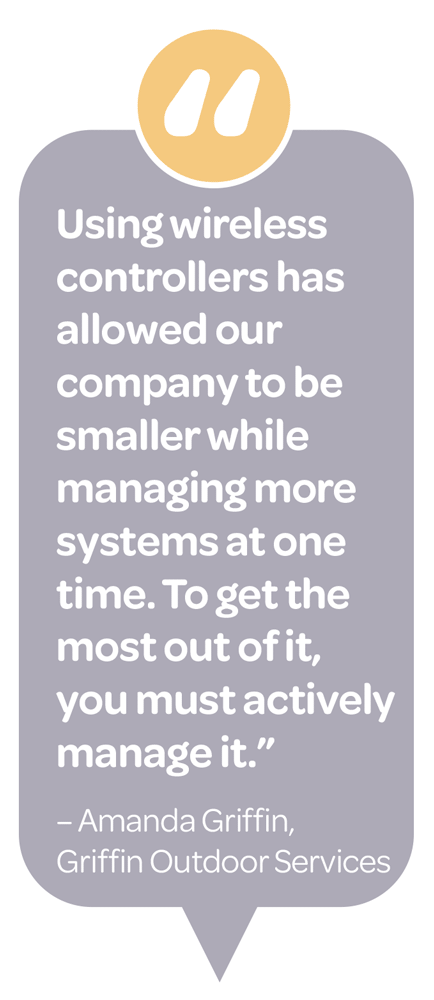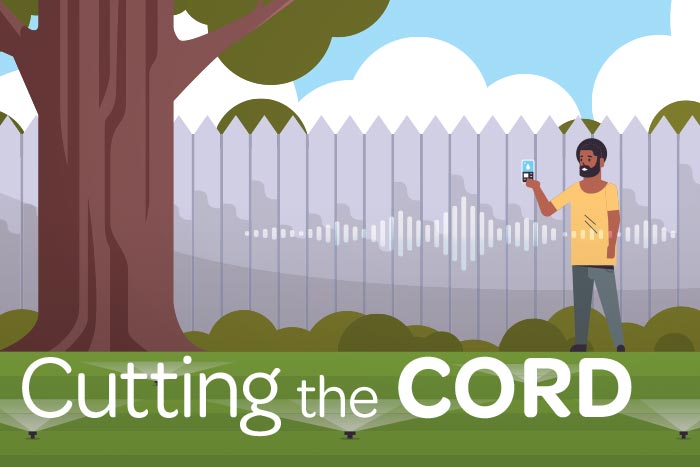As living costs continue to escalate and attention on water conservation increases, irrigation contractors have an opportunity to help clients meet both budget and sustainability goals. Even before inflation rates exploded, rising utility costs and growing water restrictions were top of mind for property owners. In some geographic regions, property owners face hefty fines for exceeding allowed water usage quantities and tight budget expenditures.
By leveraging advancements in technology, contractors can reduce water usage without sacrificing plant health to save money for their company and their clients and conserve water. Wireless irrigation controllers can be a useful tool to reach that goal.
Consider this: Amanda and John Griffin, co-owners of Griffin Outdoor Services Inc. in San Antonio, have helped one client cut their annual water budget from $1.7 million to $1.4 million over 10 years. Even as municipal water rates rise, the client’s water budget decreases.
“We have helped them cut their water expenditure by about $350,000 a year. So, even as water rates go up, their water budget goes down,” says Amanda, who is certified through the Irrigation Association as a certified irrigation contractor and certified landscape irrigation auditor.
The Griffins don’t install or repair irrigation systems. Instead, they accomplish this with wireless controllers. From their office, they can remotely monitor and adjust systems for 250 homeowner associations. If a problem is detected, the Griffins alert the customer and share the diagnostic information so the HOA can call their landscape maintenance contractor to make the repair. All clients must use a specific wireless controller to streamline their services.
 “The system we use sends messages every morning that alert us to a potential short on a zone or issue with a valve and other issues so they can have their landscape contractor send out a tech before the issue creates a major leak,” she says.
“The system we use sends messages every morning that alert us to a potential short on a zone or issue with a valve and other issues so they can have their landscape contractor send out a tech before the issue creates a major leak,” she says.
In Simsbury, Connecticut, Mark Twiss, manager of irrigation services for DW Burr Landscape & Design Inc., says the company only works on sites with wireless controllers. The company requires this for both its residential and commercial customers.
“Our rocks bleed water here in the Northeast, but that doesn’t mean we can overwater,” Twiss says. “Since I got my CIC, I see things differently. I’m a strong advocate for water conservation and won’t install a traditional controller. These new Wi-Fi controllers account for soil texture class, slope, real-time weather data, equations for rectangle or square and make it efficient to achieve that.”
The United States Environmental Protection Agency estimates that overwatering landscapes wastes 50% of outdoor watering. Wireless controllers can help reduce that number and bring cost-savings benefits to clients and contractors alike. Here, Griffin and Twiss offer insights into challenges with adopting their use and advice for overcoming them.
Wi-Fi vs. cellular connections
Wireless controllers require an internet connection. In wired urban and suburban areas, Wi-Fi service is readily available.
Twiss has noticed that clients using Wi-Fi may need a booster to strengthen the signal enough for the controller to find it, especially when the controller is in the basement or outside. Some customers purchase a Wi-Fi signal booster, which can quickly remedy the problem in these cases.
“That has been the only problem we’ve had,” he says. “It takes me about 15 seconds to change the face plates on existing systems we’re moving to wireless controllers.”
Many of Griffin’s customers rely on cellular connections to power their wireless controllers. The recent nationwide tower upgrade from 3G to 5G has meant that existing wireless controllers needed new cellular modems to function. The manufacturer Griffin uses includes this upgrade at no cost, allowing them to make the majority of changes for free to customers, though they did charge a service charge to a handful of clients.
“Tech upgrades are something you need to think about with wireless controllers. We’ve got about 98% of our accounts through the switch,” Griffin says. “There are some unique neighborhoods that took down their 3G and have not put up a 5G tower in its place, so we are not sure what those homeowners are doing for their internet. But, we are nearly finished upgrading everyone.”
Customer hesitancy
Change can be challenging for customers, especially when an investment is necessary. Price is one concern contractors always hear from clients. It will be no different with wireless controllers.
As the technology is more widely used, the cost will decrease. However, emphasizing the values that resonate with the customer, such as water savings which equate to lower utility and conservation and savings in service calls, can counteract the investment. Twiss bolsters this by explaining how a wireless controller saves the client time and money in the long run.
“I explain how if they want more or less water on their site, I can change the programming without coming on-site, which means they don’t have to pay a visit fee,” he says. “I also show them how the alerts can isolate an issue, which allows us to get a tech out there and fix it in less time.”
DW Burr services more than 1,000 accounts, and 75% have been upgraded to a wireless controller. The company does not install any conventional controllers. Twiss believes a wireless controller is appropriate for use on every irrigation system, whether there is one head or a large commercial job with 10,000 heads.
“The younger generations, especially those into technology and conservation, understand the tool and are excited about it,” he says. “We’ve been able to make every client, including one with a home on a lake, comfortable with the technology. I tell them that my phone is always on.”
Security concerns
News of data breaches and internet privacy issues frequently appear in the headlines. The hackers aren’t looking for gardening tips or water usage. They use the devices as entry points into the entire network with the home or commercial property.
For some clients who are more understanding of digital security and dealing with threats of hackers, having a Wi-Fi connection tethered to the irrigation system can feel like a liability. The Internet of Things is essential to improving efficiencies and conserving resources but can create vulnerabilities some clients are unwilling to chance. Although manufacturers continue to work on security enhancements and upgrades, recognizing a client’s policy or viewpoint of internet security may make them impractical for some sites.
Griffin acknowledges that the thought of learning new technology can be overwhelming for some contractors. But she emphasizes the significant benefits wireless controllers offer to irrigation companies and clients.
 First, wireless controllers significantly reduce fuel needs since alerts come through via the software rather than driving from site to site for a physical inspection. Second, it’s cut client costs by decreasing the number of service calls and lengths of time on-site.
First, wireless controllers significantly reduce fuel needs since alerts come through via the software rather than driving from site to site for a physical inspection. Second, it’s cut client costs by decreasing the number of service calls and lengths of time on-site.
For example, the run time can be reviewed and changed remotely rather than a customer incurring the cost of a tech visiting the property to make the change. The diagnostics also pinpoint an issue on the site, so when a tech does arrive, they can directly address the problem rather than spend excess time diagnosing the situation.
“Using wireless controllers has allowed our company to be smaller while managing more systems at one time,” she says. “To get the most out of it, you must actively manage it.”
Before going into business with her husband, Griffin worked for a manufacturer. They recognized that not everyone has that experience or comfort level in understanding how wireless controllers work. But she says resources are plentiful for getting started.
She suggests starting by connecting with the distributor and manufacturer representatives to get the information you need to install and manage wireless controllers. Many offer training on specific products and troubleshooting. The Irrigation Association’s annual Irrigation Show and Education Week is also a great resource for information on getting the most out of these tools, as well as just reaching out to other colleagues.
“Talk to other contractors who are using the technology. We mentor others and let them interview us about the technology we use,” Griffin says. “We are willing to show them the features of the controllers. We see it as more water being saved, even if we’re not managing it.”
Consumers are accustomed to technology streamlining every aspect of life and are particularly concerned about conservation efforts. Wireless controllers offer an option that can make saving water easier while also reducing contractor time spent on-site.





